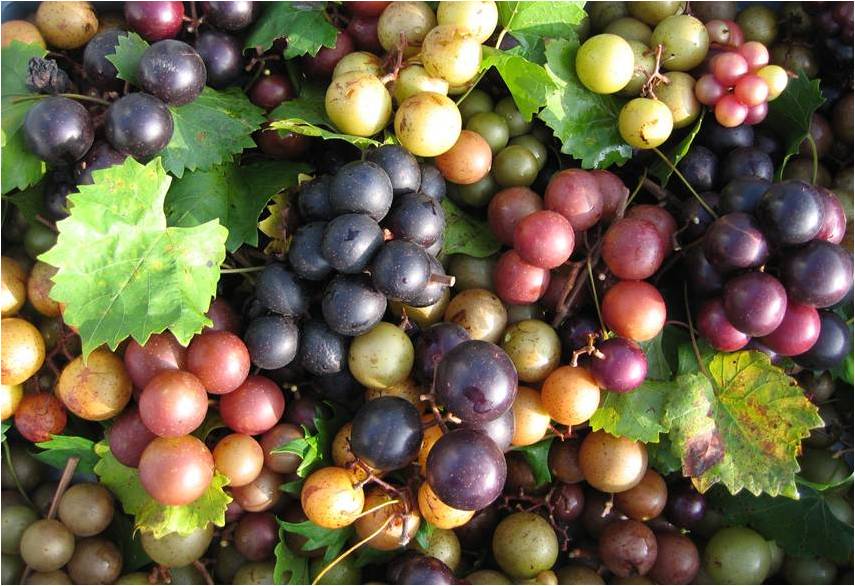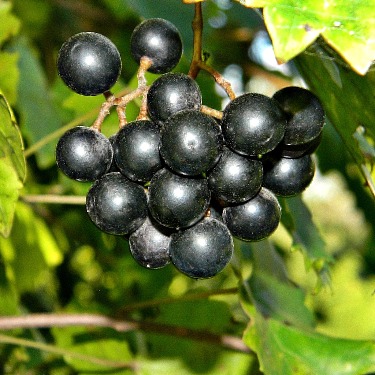
Written by s • Grow Muscadine Grapes – the Best Grapes You Will Ever Taste
If you live outside the South, the chances are your grape-eating experience is limited to the green, seedless grapes sold in supermarkets. If that is so, then you have been missing out on a sensual pleasure that is very, very different. Imagine a large, round grape with a black skin. Pop one into your mouth, bite into it and the flesh melts like ice cream, and the sweet juice, rich in exotic flavors, flows around your taste buds and down your throat. This is grape eating as you have never known it before. Welcome to the world of Muscadine Grapes.
The Muscadine grape exists in about 150 varieties in the South, all derived from a native American grape, Vitis rotundifolia. This grape grew wild from Florida north the Delaware, and west to Texas and Oklahoma, long before the land was settled. Southerners took to it because it was adapted to humidity and long, hot summer far better than the European grapes they brought with them. By selection and breeding they developed many varieties, which are being added to today by breeders at southern Universities. There is a big buzz building around Muscadine grapes too, because the polyphenol compounds that exist in high concentrations in the skin are thought to have many health benefits. Muscadines are usually eaten fresh, but you can also make delicious wine from them, usually of a sweeter, dessert-wine type. As well, they can be turned into delicious jams and grape jellies. Nothing goes to waste when you grow Muscadine grapes.
Growing Muscadine Grapes

Muscadine grapes grow best in a sunny location, with at least 6 to 8 hours of direct sun a day. They need a well-drained soil, and they will not grow well in wet locations. If necessary, build up an elevated area to plant on. Dig the soil deeply and add plenty of rich organic material – grapes are heavy feeders. You will need some kind of support system for the vines to grow on. Allow 20 feet of trellis or fence for one vine, so you could plant several along a fence.
Pest and Disease Resistance
Muscadine grapes are much easier to grow than ordinary grapes. They are resistant to diseases, including Pierce’s Disease, which has ravaged other grapes, and the Phylloxera insect, which attacks the roots. In Europe traditional grapes are grafted onto roots derived from the Muscadine, to protect them from this destructive pest. As well, the thicker skin that is characteristic of the Muscadine grape protects them from molds and other fungal diseases. This resistance to multiple pests and diseases make them a good choice for organic growing, so you can even have grapes from your garden that are totally chemical-free.
Pruning
Pruning is the key to success with grapes, and Muscadines are no exception. This is the fun part, where you get to shape and control the growth of your plants. Basic pruning is done each spring, and all weak growth is removed, leaving a framework of the strongest and youngest canes. The buds on these will develop, producing stems that carry bunches of flowers and grapes. These stems are trained along the wires or trellis, and the side-shoots pinched back to just one bunch. Without training and pruning you will get many bunches of small grapes. Pruning means fewer bunches, but they will be much bigger, with large grapes, which are best for eating.
Varieties of Muscadine Grapes
Of that 150 varieties of Muscadines, only a handful are widely grown. Unlike regular grapes, many varieties need a pollinator, which means it is best to plant at least two different types. If you only have space for a single vine, then choose a self-pollinating variety such as ‘Carlos’, which produces a crop all by itself, as well as being a good pollinator for other types. Muscadines vary in skin color, flavor, and ease of growth, so choose varieties that suit your taste and skills in the garden. Here is a selection of some of the best and most popular varieties to grow.
Popular Varieties of Muscadine Grapes to Grow at Home
Bronze – as the name suggest, this variety has a bronze-colored skin, unlike the darker skin of most other types. This is the classic variety also known as ‘Skuppernong’ and is one of the original heir-loom forms of the Muscadine grape.
Carlos – this is a very popular variety, since it is self-pollinating. Just one plant will have a heavy crop, so if you want to experience Muscadines, this one is a good place to start. It has bronze skin and is perfect for eating fresh or making wine.
Frye – this is another bronze-skinned type, derived from the bronze Skuppernong. It produces very large, very sweet grapes that are also seedless, which some people prefer. The crop ripens in September, and this variety loves the hottest areas.
Higgins – this is a variety with large, bronze to brown grapes, which ripen in August and September. It has a thicker skin – where all those healthy compounds are – which is completely edible. Plant with another variety for a full crop.
Southland – this black-fruited variety is the top-choice for colder regions, and it is self-fertile too. If you live in zone 6, this is the one to choose, and you will love it rich flavor. Great eaten fresh or turned into jelly.
Summit – this is another cold-hardy and disease resistant form, with bronze fruit. Pair it with ‘Southland’ for the perfect combination of flavors. This is a super-sweet variety you will love to eat fresh.
Which ever variety you grow, you are going to love the novelty and newness of Muscadine grapes. They are easy to grow – the top choice if you live in a warm, humid state – so what are you waiting for? Planting time has arrived.





